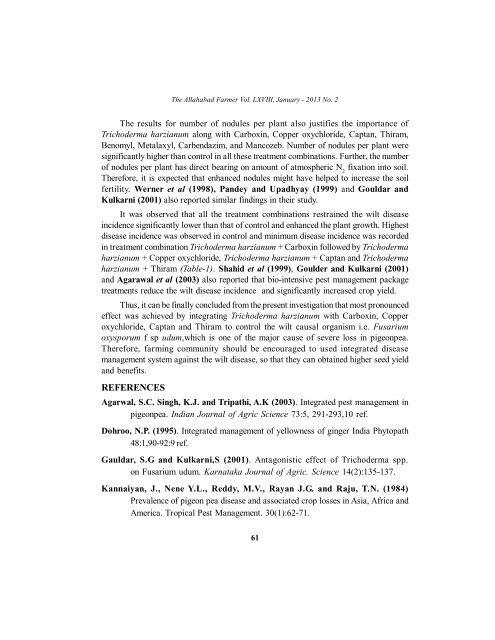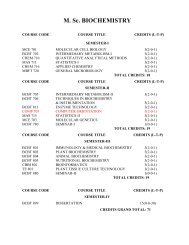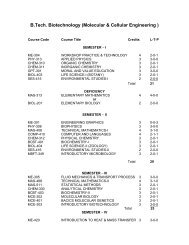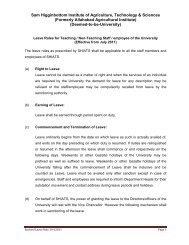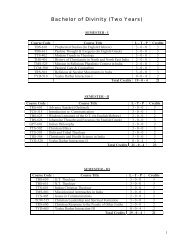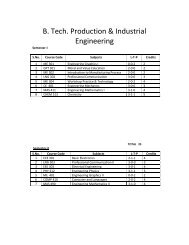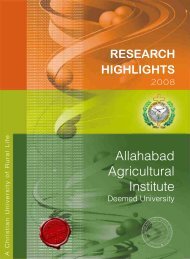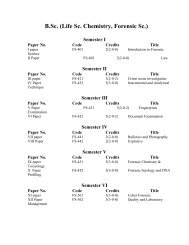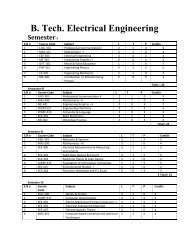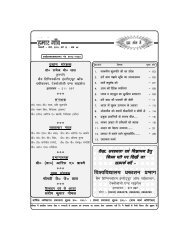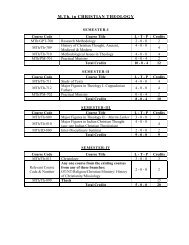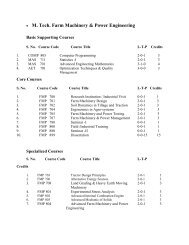Study of Hygienic practices of street food vendors in ... - Shiats.edu.in
Study of Hygienic practices of street food vendors in ... - Shiats.edu.in
Study of Hygienic practices of street food vendors in ... - Shiats.edu.in
You also want an ePaper? Increase the reach of your titles
YUMPU automatically turns print PDFs into web optimized ePapers that Google loves.
The Allahabad Farmer Vol. LXVIII, January - 2013 No. 2The results for number <strong>of</strong> nodules per plant also justifies the importance <strong>of</strong>Trichoderma harzianum along with Carbox<strong>in</strong>, Copper oxychloride, Captan, Thiram,Benomyl, Metalaxyl, Carbendazim, and Mancozeb. Number <strong>of</strong> nodules per plant weresignificantly higher than control <strong>in</strong> all these treatment comb<strong>in</strong>ations. Further, the number<strong>of</strong> nodules per plant has direct bear<strong>in</strong>g on amount <strong>of</strong> atmospheric N 2fixation <strong>in</strong>to soil.Therefore, it is expected that enhanced nodules might have helped to <strong>in</strong>crease the soilfertility. Werner et al (1998), Pandey and Upadhyay (1999) and Gouldar andKulkarni (2001) also reported similar f<strong>in</strong>d<strong>in</strong>gs <strong>in</strong> their study.It was observed that all the treatment comb<strong>in</strong>ations restra<strong>in</strong>ed the wilt disease<strong>in</strong>cidence significantly lower than that <strong>of</strong> control and enhanced the plant growth. Highestdisease <strong>in</strong>cidence was observed <strong>in</strong> control and m<strong>in</strong>imum disease <strong>in</strong>cidence was recorded<strong>in</strong> treatment comb<strong>in</strong>ation Trichoderma harzianum + Carbox<strong>in</strong> followed by Trichodermaharzianum + Copper oxychloride, Trichoderma harzianum + Captan and Trichodermaharzianum + Thiram (Table-1). Shahid et al (1999), Goulder and Kulkarni (2001)and Agarawal et al (2003) also reported that bio-<strong>in</strong>tensive pest management packagetreatments r<strong>edu</strong>ce the wilt disease <strong>in</strong>cidence and significantly <strong>in</strong>creased crop yield.Thus, it can be f<strong>in</strong>ally concluded from the present <strong>in</strong>vestigation that most pronouncedeffect was achieved by <strong>in</strong>tegrat<strong>in</strong>g Trichoderma harzianum with Carbox<strong>in</strong>, Copperoxychloride, Captan and Thiram to control the wilt causal organism i.e. Fusariumoxysporum f sp udum,which is one <strong>of</strong> the major cause <strong>of</strong> severe loss <strong>in</strong> pigeonpea.Therefore, farm<strong>in</strong>g community should be encouraged to used <strong>in</strong>tegrated diseasemanagement system aga<strong>in</strong>st the wilt disease, so that they can obta<strong>in</strong>ed higher seed yieldand benefits.REFERENCESAgarwal, S.C. S<strong>in</strong>gh, K.J. and Tripathi, A.K (2003). Integrated pest management <strong>in</strong>pigeonpea. Indian Journal <strong>of</strong> Agric Science 73:5, 291-293,10 ref.Dohroo, N.P. (1995). Integrated management <strong>of</strong> yellowness <strong>of</strong> g<strong>in</strong>ger India Phytopath48:1,90-92:9 ref.Gauldar, S.G and Kulkarni,S (2001). Antagonistic effect <strong>of</strong> Trichoderma spp.on Fusarium udum. Karnataka Journal <strong>of</strong> Agric. Science 14(2):135-137.Kannaiyan, J., Nene Y.L., Reddy, M.V., Rayan J.G. and Raju, T.N. (1984)Prevalence <strong>of</strong> pigeon pea disease and associated crop losses <strong>in</strong> Asia, Africa andAmerica. Tropical Pest Management. 30(1):62-71.61


